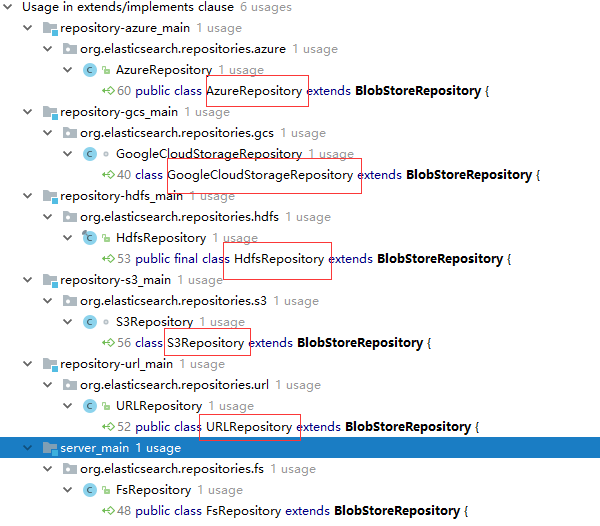elasticSearch6源码分析(8)RepositoriesModule模块
1.RepositoriesModule概述
Sets up classes for Snapshot/Restore
1.1 snapshot概述
A snapshot is a backup taken from a running Elasticsearch cluster. You can take a snapshot of individual indices or of the entire cluster and store it in a repository on a shared filesystem, and there are plugins that support remote repositories on S3, HDFS, Azure, Google Cloud Storage and more. Snapshots are taken incrementally. This means that when creating a snapshot of an index Elasticsearch will avoid copying any data that is already stored in the repository as part of an earlier snapshot of the same index. Therefore it can be efficient to take snapshots of your cluster quite frequently. Snapshots can be restored into a running cluster via the restore API. When restoring an index it is possible to alter the name of the restored index as well as some of its settings, allowing a great deal of flexibility in how the snapshot and restore functionality can be used.
1.2 repository
You must register a snapshot repository before you can perform snapshot and restore operations. We recommend creating a new snapshot repository for each major version. The valid repository settings depend on the repository type. If you register same snapshot repository with multiple clusters, only one cluster should have write access to the repository. All other clusters connected to that repository should set the repository to readonly mode.
实例:备份
PUT /_snapshot/my_backup
{
"type": "fs",
"settings": {
"location": "my_backup_location"
}
}
恢复
POST /_snapshot/my_backup/snapshot_1/_restore
删除
DELETE /_snapshot/my_backup/snapshot_1
监控
GET /_snapshot/my_backup/snapshot_1/_status
2.配置类BlobStoreRepository
protected BlobStoreRepository(RepositoryMetaData metadata, Settings globalSettings, NamedXContentRegistry namedXContentRegistry) {
super(globalSettings);
this.metadata = metadata;
this.namedXContentRegistry = namedXContentRegistry;
snapshotRateLimiter = getRateLimiter(metadata.settings(), "max_snapshot_bytes_per_sec", new ByteSizeValue(40, ByteSizeUnit.MB));
restoreRateLimiter = getRateLimiter(metadata.settings(), "max_restore_bytes_per_sec", new ByteSizeValue(40, ByteSizeUnit.MB));
readOnly = metadata.settings().getAsBoolean("readonly", false);
indexShardSnapshotFormat = new ChecksumBlobStoreFormat<>(SNAPSHOT_CODEC, SNAPSHOT_NAME_FORMAT,
BlobStoreIndexShardSnapshot::fromXContent, namedXContentRegistry, isCompress());
indexShardSnapshotsFormat = new ChecksumBlobStoreFormat<>(SNAPSHOT_INDEX_CODEC, SNAPSHOT_INDEX_NAME_FORMAT,
BlobStoreIndexShardSnapshots::fromXContent, namedXContentRegistry, isCompress());
ByteSizeValue chunkSize = chunkSize();
if (chunkSize != null && chunkSize.getBytes() <= 0) {
throw new IllegalArgumentException("the chunk size cannot be negative: [" + chunkSize + "]");
}
}
配置类的实现

3.重点类
3.1 SnapshotsService
创建snapshot
/**
* Service responsible for creating snapshots
* <p>
* A typical snapshot creating process looks like this:
* <ul>
* <li>On the master node the {@link #createSnapshot(SnapshotRequest, CreateSnapshotListener)} is called and makes sure that no snapshots is currently running
* and registers the new snapshot in cluster state</li>
* <li>When cluster state is updated the {@link #beginSnapshot(ClusterState, SnapshotsInProgress.Entry, boolean, CreateSnapshotListener)} method
* kicks in and initializes the snapshot in the repository and then populates list of shards that needs to be snapshotted in cluster state</li>
* <li>Each data node is watching for these shards and when new shards scheduled for snapshotting appear in the cluster state, data nodes
* start processing them through {@link SnapshotShardsService#processIndexShardSnapshots(ClusterChangedEvent)} method</li>
* <li>Once shard snapshot is created data node updates state of the shard in the cluster state using the {@link SnapshotShardsService#sendSnapshotShardUpdate(Snapshot, ShardId, ShardSnapshotStatus)} method</li>
* <li>When last shard is completed master node in {@link SnapshotShardsService#innerUpdateSnapshotState} method marks the snapshot as completed</li>
* <li>After cluster state is updated, the {@link #endSnapshot(SnapshotsInProgress.Entry)} finalizes snapshot in the repository,
* notifies all {@link #snapshotCompletionListeners} that snapshot is completed, and finally calls {@link #removeSnapshotFromClusterState(Snapshot, SnapshotInfo, Exception)} to remove snapshot from cluster state</li>
* </ul>
*/
3.2 RestoreService
/**
* Service responsible for restoring snapshots
* <p>
* Restore operation is performed in several stages.
* <p>
* First {@link #restoreSnapshot(RestoreRequest, org.elasticsearch.action.ActionListener)}
* method reads information about snapshot and metadata from repository. In update cluster state task it checks restore
* preconditions, restores global state if needed, creates {@link RestoreInProgress} record with list of shards that needs
* to be restored and adds this shard to the routing table using {@link RoutingTable.Builder#addAsRestore(IndexMetaData, SnapshotRecoverySource)}
* method.
* <p>
* Individual shards are getting restored as part of normal recovery process in
* {@link IndexShard#restoreFromRepository(Repository)} )}
* method, which detects that shard should be restored from snapshot rather than recovered from gateway by looking
* at the {@link ShardRouting#recoverySource()} property.
* <p>
* At the end of the successful restore process {@code RestoreService} calls {@link #cleanupRestoreState(ClusterChangedEvent)},
* which removes {@link RestoreInProgress} when all shards are completed. In case of
* restore failure a normal recovery fail-over process kicks in.
*/
elasticSearch6源码分析(8)RepositoriesModule模块的更多相关文章
- elasticSearch6源码分析(5)gateway模块
1.gateway概述 The local gateway module stores the cluster state and shard data across full cluster res ...
- elasticSearch6源码分析(4)indices模块
1.indices概述 The indices module controls index-related settings that are globally managed for all ind ...
- elasticSearch6源码分析(3)cluster模块
1. cluser概述 One of the main roles of the master is to decide which shards to allocate to which nodes ...
- 【转】Spark源码分析之-deploy模块
原文地址:http://jerryshao.me/architecture/2013/04/30/Spark%E6%BA%90%E7%A0%81%E5%88%86%E6%9E%90%E4%B9%8B- ...
- ADB 源码分析(一) ——ADB模块简述【转】
ADB源码分析(一)——ADB模块简述 1.Adb 源码路径(system/core/adb). 2.要想很快的了解一个模块的基本情况,最直接的就是查看该模块的Android.mk文件,下面就来看看a ...
- 使用react全家桶制作博客后台管理系统 网站PWA升级 移动端常见问题处理 循序渐进学.Net Core Web Api开发系列【4】:前端访问WebApi [Abp 源码分析]四、模块配置 [Abp 源码分析]三、依赖注入
使用react全家桶制作博客后台管理系统 前面的话 笔者在做一个完整的博客上线项目,包括前台.后台.后端接口和服务器配置.本文将详细介绍使用react全家桶制作的博客后台管理系统 概述 该项目是基 ...
- elasticsearch源码分析之search模块(server端)
elasticsearch源码分析之search模块(server端) 继续接着上一篇的来说啊,当client端将search的请求发送到某一个node之后,剩下的事情就是server端来处理了,具体 ...
- elasticsearch源码分析之search模块(client端)
elasticsearch源码分析之search模块(client端) 注意,我这里所说的都是通过rest api来做的搜索,所以对于接收到请求的节点,我姑且将之称之为client端,其主要的功能我们 ...
- (一) Mybatis源码分析-解析器模块
Mybatis源码分析-解析器模块 原创-转载请说明出处 1. 解析器模块的作用 对XPath进行封装,为mybatis-config.xml配置文件以及映射文件提供支持 为处理动态 SQL 语句中的 ...
随机推荐
- 初始kafka
kafka 简介 Kafka是Linkedin于2010年12月份开源的消息系统 一种分布式的.基于发布/订阅的消息系统 ,另外提供数据分布式缓存功能 特点 消息持久化:通过O(1)的磁盘数据结构提供 ...
- iOS cell左滑出现多个功能按钮(IOS8以后支持)
#import "ViewController.h" #import "Swift_OC-Swift.h" @interface ViewController ...
- unidbgrid显示列的合计值
procedure TfrmClient.UniDBGrid1ColumnSummaryResult(Column: TUniDBGridColumn; GroupFieldValue: Varian ...
- 工作随笔——pinpoint分布式性能监控工具(docker安装)
在做性能压测的时候,你是不是有只能看到测试报告? 在做性能压测的时候,你是不是想知道每一个方法执行了多长时间? Pinpoint几乎可以帮助你查看你想看到的每一个细节. Pinpoint是什么? Pi ...
- Asp .Net core 2 学习笔记(1) —— Starup
这个系列的初衷是便于自己总结与回顾,把笔记本上面的东西转移到这里,态度不由得谨慎许多,下面是我参考的资源: ASP.NET Core 中文文档目录 官方文档 记在这里的东西我会不断的完善丰满,对于文章 ...
- 背水一战 Windows 10 (42) - 控件(导航类): Frame 动画
[源码下载] 背水一战 Windows 10 (42) - 控件(导航类): Frame 动画 作者:webabcd 介绍背水一战 Windows 10 之 控件(导航类) Frame 动画 示例An ...
- 背水一战 Windows 10 (49) - 控件(集合类): Pivot, Hub
[源码下载] 背水一战 Windows 10 (49) - 控件(集合类): Pivot, Hub 作者:webabcd 介绍背水一战 Windows 10 之 控件(集合类) Pivot Hub 示 ...
- prometheus比zabbix好在哪点?
分享网易云轻舟微服务选择基于 Prometheus 开发微服务监控系统的考量: 开源 云原生 与微服务监控需求的匹配度很高 开源 Prometheus是CNCF(云原生计算基金会)旗下成熟的开源项目, ...
- 「PKUSC2018」最大前缀和(状压dp)
前言 考试被\(hyj\)吊着打... Solution 考虑一下如果前缀和如果在某一个位置的后面的任意一个前缀和都<=0,肯定这就是最大的. 然后这样子就考虑左右两边的状压dp,然后就好了. ...
- Python 库,资源
库名称简介 Chardet字符编码探测器,可以自动检测文本.网页.xml的编码. colorama主要用来给文本添加各种颜色,并且非常简单易用. Prettytable主要用于在终端或浏览器端构建格式 ...
